The origin of Uzbek national KURASH begins from ancient times and this proved by several historical memorials.
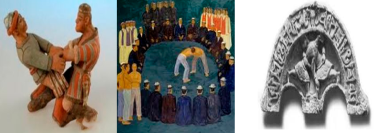
Presently, Archeological excavations in Uzbekistan have revealed ancient paintings depicting methods of fighting, including methods of peaceful settlement of disputes and capture of the enemy.
It is important to mention, that before the competitions, exercises whith throwing, jumping, and demonstration of strength were performed. They served as a means of warming up the opponents before the matches. Wrestlers began to fight by holding each other's leather belts or different parts of their outer clothing. After completing the method of throwing the opponent to the ground, great attention is paid to the hooking of the legs and the method of striking.
In the peoples living in the territory of Uzbekistan, the competition continued until the first throw. These competitions were held to the sound of national music and the winner of the competition was highly respected by the people.

The Wrestlers' matches were the centerpiece of celebrations for victories, family celebrations, or seasonal festivals.
Presently, the two types of wrestling have been formed since ancient times: grabbing the opponent's belt in advance and free grabbing the opponent in the territory of Uzbekistan. The first type of wrestling was called the "Fergan style", the second - the "Bukhara" style.
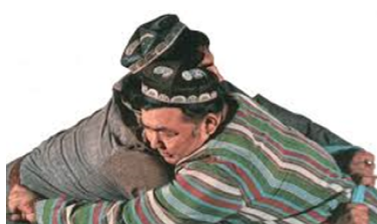
Various types of Belbogli Kurash are popular among the people, in which wrestlers use striped cloaks and simple national belts.
Wrestlers mostly won by lifting the opponent and twisting the wrestler whose leg was off the ground, technical methods were rarely used, mainly lifting and twisting techniques were used. Belbogli Kurash wrestlers have gained experience by fighting in many weddings.
Over the years, Belbogli kurash to develop step by step.
During the years of independence of Uzbekistan, significant changes began to occur in the sport of Belbogli Kurash. Firstly, the first Belbogli Kurash federation was founded in 2001. The federation officially began to operate on the basis of a certificate issued by the Ministry of Justice according to the order 506 on
February 1, 2002.
Competition is a part of the training process. The goal of participating in competitions is to win or to occupy the highest possible places. During the training process, it is usually not possible to create conditions for the athlete to demonstrate at a high level all the qualities that help him achieve high sports results. Every athlete strives to defeat his opponent and this desire requires the athlete to mobilize all his abilities during the competitions. It not only allows to show the functional capabilities of a person, but also serves as a means of their formation.
Competitions help to solve the following tasks:
to determine the state of training work in the sports team;
determine the level of training of wrestlers;
to complete the educational and training work at each stage of preparation;
to help promote wrestling and increase the number of participants.
According to the characteristics of the Belbogli Kurash competitions, they are as follows
a) individual;
b) collective;
c) individual-collective;
d) classification.
In individual competitions, the places taken by the participants in each weight category are determined. In collective competitions, the place of the teams will be determined. In individual-collective competitions, the places occupied by the participants and teams are determined at the same time. In classification competitions - it can be held for the purpose of collecting sport ranks, rating points, and qualifying participants for the Olympic Games, depending on the places occupied by the participants.
The results shown by the participants are taken into account when awarding or confirming the titles and ranks according to the sport categories.
According to the method of organizing the competitions, they are divided into the following;
а)Circulation system;
b) Circulation-exclusion system;
c) Mixed system;
d) Olympic system.
According to the stages of the competitions, they are divided into district, region, Republic, Asia, World and others. The concepts of championship and primacy in competitions are understood differently. Actually, due to the fact that they are similar in terms of content and essence, it creates a debate among experts. These concepts also require their precise definition.
The "Championship" refers to competitions held for district, regional, republican, Asian, and world championships among adults only according to the stage of the competition. The wrestler who takes the first place in these championships will be awarded the title of "champion".
The Championships are planned to be held once a year according to the stage of the competition in wrestling.
The Primacy refers to the competitions held to win the first place among people of other ages than adults (teenagers, young people, veterans) according to the stage of the competition. The wrestler who takes the first place in these championships will have the title of "winner".


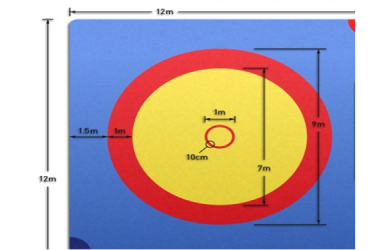
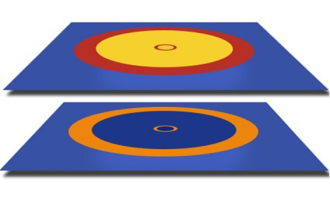
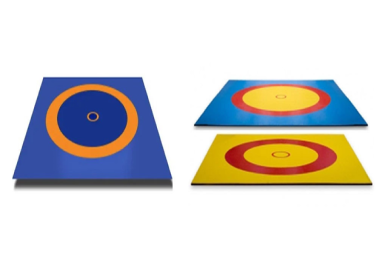
The board of referees for serving in the competitions is appointed by the referee commission of the Belbogli Kurash Federation and approved by the sports organization holding the competition. The board of referees consists of the chief referee, chief secretary, mat leader, arbitrator, assistant referee, stopwatch-referee, informant-referee, competition doctor.
The Chief Referee heads the panel of judges at the competition, is responsible for the organization of the competition and the relevant wrestling federation for the conduct of the competition.
Before the start of the competition, the chief referee must check the fitness of the sports hall where the competition will be held, rooms for the secretariat, equipment, tools, necessary documents and their compliance with the current regulations.
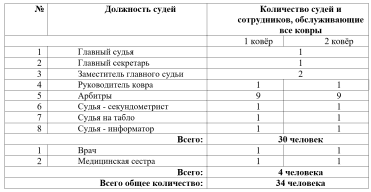
On the eve of the competition, the chief referee holds a panel of judges and distributes responsibilities among the judges, appoints a commission to determine the weights of the participants, and also creates a brigade of judges based on the number of mats. During the competitions, the chief referee manages their conduct in accordance with the rules of the competitions and the regulations of the competition.
In some cases, if facilities or equipment are in an unusable condition before the start of the competition, the referee cancels the competition, or due to unfavorable meteorological conditions or any other reason that prevents the competition from being held. may give a temporary break.
On the last day of the competition, the chief referee holds the final meeting of referees, team representatives, trainers, confirms the results and evaluates all the work done.
Duties of the general secretary of competitions
The general secretary of the competitions writes the minutes of the meeting of the jury, conducts the drawing ceremony and determines the order of competitions, draws up the schedule of competitions, fills out all referee documents, accepts applications and protest notices, about them informs the referee, prepares a technical report on the conduct of competitions.
Duties of mat referee
The duties of the mat manager are superior, he coordinates the work of the arbitrator and side judge. He must carefully monitor the progress of the competition and evaluate the technical actions of the referees and athletes in accordance with the rules of the competition. In case of disagreement between the referees, one has the right to make his own decision, but he is never the first to express his opinion, but listens to the opinion of the referee and the arbitrator. In case of disagreement between the referee and the referee, he has the right to make his own decision, but he is never the first to express his opinion, but listens to the opinion of the referee and the arbitrator. If the referees agree on the evaluation of the movement situations of the athletes, the mat manager does not interfere with the decision of the referees.
The referee in the middle
The referee in the middle performs the most responsible task during the direct refereeing of the competition. He manages the course of the competition, evaluates the actions of the wrestlers and monitors the progress of the competition according to the rules of the competition.
Signals the start of the competition, stops and ends the competition, decides to continue the competition standing or parterre, depending on the approval of the referee or mat leader. During the competition, the arbitrator must stand in such a place that he can clearly assess the movements of the wrestlers. It is necessary for the wrestlers to see the whole body, to be able to anticipate the direction of their movements and throws, to evaluate them correctly and to be ready to prevent incorrect and prohibited movements at any time.
The referee evaluates the technical actions of the wrestlers and records them in a special protocol.
The referee in the middle should express his opinion regardless of the situation, his opinions may or may not be consistent with the referee's opinions when evaluating the actions of the wrestlers.
During the competition, if the referee notices one or another technical movement of the wrestlers, and the referee did not see these movements or did not pay attention to them, he must inform the referee about this. In a blue or green belt fight, he must raise the special indicator in the colors, even if the referee in the middle does not give his opinion. With the development of current technical devices, special indicators can be performed using a computer. The timekeeper-referee warns wrestlers, referees and spectators about the time. It records the time of net victory, determines the delays of wrestlers, takes into account the loss of time that does not apply to the course of the competition. He performs all his actions in agreement with the leader of the mat and the arbiter: the arbiter turns on and off the stopwatch. If the match is stopped due to an injury or a defect in the wrestler's clothing, the timekeeper-referee will announce the time at the end of each minute. At the end of the competition, the timekeeper-referee stops the stopwatch and gives a sound signal. He should do this at the same time.
Reporter-referee
The announcer-referee announces the program and order of the competitions, informs the audience about the progress of the competition, announces the results of each competition, the composition of the next couple, explains some cases of the rules of the competition, and the sports activities of the participants of the competition. All information about the progress of the competition is given with the permission of the chief referee of the competition.
The doctor of the competition is part of the jury, he is responsible for the medical examination of the participants and the sanitary and hygienic conditions of the competitions. The doctor performs a medical examination of the athletes during the weighing and, if necessary, makes a decision on whether to allow the participants to participate in the competition. He must provide medical care when the participant is injured or sick. During the competition, medical assistance will be provided outside the mat.
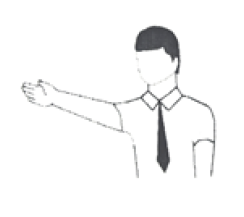
1. "TANISHTIRISH” (engl. “introduction") - After the wrestlers come to the wrestling mat, the referee in the middle will introduce the athletes to each other pointing first his right, then his left hand.
At this time, the announcing referess will introduce the athletes.
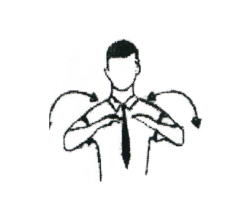
2. "TAZIM” (engl. “Bow down”) - The referee in the middle will open both hands to the sides with his palms facing forward, then makes the gesture of turning the hands inwards by bending them upwards with the fingers pointing upwards. At this time, the fingers of both hands may touch each other.

3. "USHLA" (engl. “catch”)" - The referee's signal for the two wrestlers to hold each other's belts. The wrestlers grab the belt by passing their hand under their opponent's left arm and their left hand over their opponent's right arm.

4. "KURASH” (engl. “Fight") - A signal used by wrestlers to begin a wrestling after grabbing their belts. The referee in the middle gestures with his right hand palm to the side, slightly bent at the elbow, and begins the contest by saying the phrase "FIGHT" in a loud voice.

5. "Stop" - A gesture used to stop a process of wrestling while the wrestling is in progress. After this signal of the referee, the athletes stop the competition.
A stop sign is given at the following points:
- if one of the wrestlers step outside the mat line during the wrestling;
- this signal will be given after completing any wrestlers’ techniques.

6. “Halol” (eng. “Honest win”) - A signal used when one of the wrestlers has gained a clean victory. The referee in the middle raises his hand up and clasps his fingers, palm facing forward, loudly saying "HALOL".
“Halol” assessment is given in the following cases:
- When one of the wrestlers picks up the opponent and knocks the opponent down with both sholders.
- Also, the grade "HALOL" is given, when the wrestlers come to the carpet line during the movement or complete the technique on the half line.
- If a wrestler receives two "YONBOSH" ratings.
- If a wrestler gets one "YONBOSH" and three "CHALA" grades.
- If a wrestler gets six "CHALA" grades.
- At the time of using the technique, the opponent removes his hand from the belt on purposely.
- If a wrestler gets three “JAZO” (engl. “PENALTY”) warnings.
- If one of the wrestlers does not go to the mat within 3 minutes.
- If one of the wrestlers is not allowed to go on the mat due to an injury, according to the doctor's opinion.

7. "YONBOSH" (engl. “side”) - The referee points to the side by extending his hand with the palms facing down (fingers are plastered in one place).
"Yonbosh" grade is given in the following cases:
If one of the wrestlers picks up his opponent, pulls him off the mat and knocks him down on one shoulder.

8. "CHALA" (engl. “incomplete”) - A gesture made by the referee by bending his arm at the elbow with the palm facing forward.
"CHALA" grade is given in the following cases:
When one of the wrestlers uses a technique and fails to complete the technique to the end;
- If the wrestler knocks his opponent two knees on the carpet;
- If a wrestler puts his opponent to sit down;
- If a wrestler touches his opponent's feet on the mat without removing his feet from the mat;
- If a wrestler knocks his opponent's leg off the mat and he falls to the mat with both sholders.
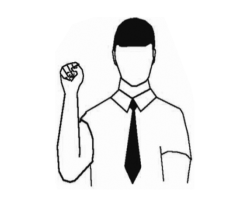
9. "JAZO” (engl. “punishment”) - A signal given to warn wrestlers.
The sign "JAZO" is given in the following cases:
- If a wrestler gains a "JAZO" grade three times during the competition, he will be declared defeated.
- If the wrestlers do not grab the belts within 20 seconds after the "USHLA" command;
- If a wrestler puts his hand on his opponent's waist for the purpose of defense (block);
- If a wrestler grabs his opponent's clothes by attaching them to his belt;
- If a wrestler kicks his opponent's leg from behind, from the side;
- If the opponent's foot is placed next to you and bends;
- If a wrestler does not come out within one minute of being called to the mat;
- Take a step and press the opponent;
- If the wrestler's coach insults the referees or the rival wrestler during the competition by disrespecting and rudely;
- If a wrestler wears a uniform of another sport instead of a wrestling uniform or wears a dirty uniform. (A form against the rules of “Belbogli Kurash”).

10.“G’IRROM” (engl. “cheating”) - is given in the following cases:
- If one of the wrestlers is not on the mat within two minutes.
- If one of the wrestlers is not allowed to go on the mat due to an injury according to a doctor's opinion.
- If he intentionally injures his opponent.
- Referees and spectators use inappropriate words or shout at Shani.
- If a wrestler receives a "JAZO" rating three times during the competition, he will be declared defeated;
- If the wrestlers do not get the required grade in the specified time, if they do not show results even during the short catch, if they deliberately cause the time to be extended, then both wrestlers will be disqualified.

11.«BEKOR» (engl. “cancel”) - This signal used after the suspension of the competition when the actions or the techniqu performed are deemed unworthy of evaluation. With his hand facing forward, the referee makes a gesture by pressing the fingers of his palm two to three times to the left and to the right.
"BEKOR" grade is given in the following cases:
- If both wrestlers are tied after the wrestlers have completed the technique
- If three referees show the three different signs..
- A movement that starts on the carpet line ends outside the carpet.

12. “VAQT” (engl. “time”) - The signal given when the timekeeper announces the end of the competition or when the "bong" is sounded. With this gesture, the wrestlers' competition ends.
Notice:
- It is strictly forbidden to grab a hand by the waist.
- if the points are equal (2 half-balls or one half-ball, etc.), the athlete who scored the last point wins. In Belbogli Kurash, if the wrestlers do not receive points at the end of the contest's time or both wrestlers have a penalty score, then the wrestlers will continue the contest with their belts short and will fight until the first technical method is used.
- A wrestler's belt is tied one fist away from the chest.
- The first part of the wrestler's body that touches the mat is taken into account when evaluating the techniques performed during the competition.
 If the wrestler's trainer is dissatisfied with the judge's assessment, the challenger throws one of the cubes shown in this picture. In this case, the head referee will watch the video recording and if the challenge is justified, the point will be returned, if the challenge is unjustified, the opponent will be given one point and the referees will remain at the table as a penalty for the challenge..
If the wrestler's trainer is dissatisfied with the judge's assessment, the challenger throws one of the cubes shown in this picture. In this case, the head referee will watch the video recording and if the challenge is justified, the point will be returned, if the challenge is unjustified, the opponent will be given one point and the referees will remain at the table as a penalty for the challenge..
 In Belbogli Kurash, referees appear with blue and green belts in their hands. He stops the wrestlers from moving and evaluates the move by raising the tied arm.
In Belbogli Kurash, referees appear with blue and green belts in their hands. He stops the wrestlers from moving and evaluates the move by raising the tied arm.
 A yellow card is issued when an athlete or coach makes rude actions to the referees and is expelled from the competition.
A yellow card is issued when an athlete or coach makes rude actions to the referees and is expelled from the competition.
A red card is given by an athlete or a coach when the referees are made very rude actions and in cases that lead to serious reasons, and they are suspended from competitions for up to 3 years.
The uniform of the referees will be black suit pants, white shirt, black socks and sports polo depending on the season.
HALOL = 6
G’IRROM = 6
YONBOSH =3
JAZO =1
CHALA =1
